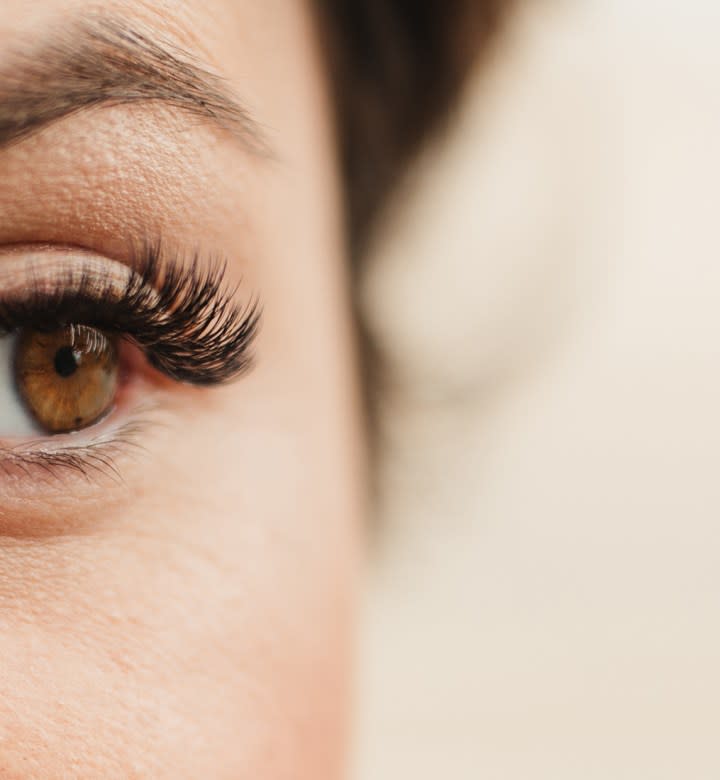We Ask a Derm: How Worried Should We Actually Be About Lash Serums?

Recently, it was brought to our attention on TikTok that there’s been some alarming discourse happening around the safety of lash serums. Namely, that it can “melt the fat underneath your eyes,” thereby exacerbating the appearance of dark circles. To help clarify whether there’s any truth to this claim, we spoke to a board-certified dermatologist Marisa Garshick.
Meet the Expert
Dr. Marisa Garshick, MD, FAAD, is a leading board-certified dermatologist in New York City. She is a clinical assistant professor of dermatology at New York Presbyterian-Weill Cornell Medicine. She completed her undergraduate education at Emory University and attended medical school at Tufts University School of Medicine, where she graduated with Research Honors and Alpha Omega Alpha. As a medical student, Dr. Garshick was awarded the Doris Duke Clinical Research Fellowship at Harvard Medical School, during which she performed dermatology clinical trials and research at Massachusetts General Hospital. Dr. Garshick’s post-graduate training in dermatology began with an internship at Memorial Sloan Kettering Cancer Center. She completed her dermatology residency at Cornell’s New York Presbyterian Hospital, where she served as Chief Resident in Dermatology.
Are Lash Serums Safe to Use?
“Overall, lash serums can be considered a safe and effective way to improve the length, thickness and overall appearance of the lashes,” says Dr. Garshick. But since there are many different lash serums that are available to us, it’s important to note that, “the prescription lash growth product, Latisse, is the only FDA-approved product to enhance eyelash growth.”
“Latisse’s main ingredient is bimatoprost, which is a prostaglandin analog,” explains Dr. Garshick. Prostaglandins are lipids that are naturally found in the body that have hormone-like effects, and synthetic forms of prostaglandins have been used in various medical treatments, including the treatment of glaucoma. Bimatoprost, specifically, was initially used in a glaucoma drug called Lumigan, but it made its way into lash serums after some patients noticed that their lashes were growing in longer and fuller. Here’s where things get a little (ahem) hairy: Not all lash serums use the same ingredients.
As the American Academy of Ophthalmology explains, “Beauty aisles are filled with over-the-counter serums promising to mimic Latisse's effects. But there are important differences. Bimatoprost, the prostaglandin analog found in Latisse, is FDA-approved. But isopropyl cloprostenate, the prostaglandin analog often found in over-the-counter products, is not. Because these over-the-counter serums have not been FDA tested, their safety and effects are not known. Latisse is the only eyelash growth serum currently approved by the FDA.”
What Are Some of the Potential Side Effects of Using a Lash Serum?
“Some side effects that have been reported with use of prostaglandin analogs like bimatoprost include hyperpigmentation or darkening of the eyelids, as well as loss of fat around the eyes, among other changes, in a condition known as prostaglandin-associated periorbitopathy,” explains Dr. Garshick. “While this certainly doesn’t happen to everyone who uses prostaglandin analogs, it is important to use them with caution and stop use if you notice any changes developing,” she adds. (Also note that many of these changes are tied to long-term use of prostaglandin analogs, which is why it’s often advised to take breaks between treatments to minimize the potential for these side effects.)
Another thing: “As with anything that comes into close contact with the eyes, there is a risk of irritation, sensitivity, itching or dryness, so it is good to be mindful of these potential side effects and stop using the product if this occurs. Also, make sure your hands are clean prior to applying any of these products close to the eye, to minimize the chance of infection,” says Dr. Garshick.
Are There Any Alternative Ingredients I Can Use?
“Some people prefer to use non-prostaglandin lash enhancers, which may contain ingredients like peptides, hyaluronic acid, biotin, castor oil and antioxidants designed to nourish, strengthen and promote the overall health of the lashes. While there is limited evidence for some of these other ingredients, anecdotally, some people see improvement when using them and they’re not associated with the same risks carried with prostaglandin,” shares Dr. Garschick.

